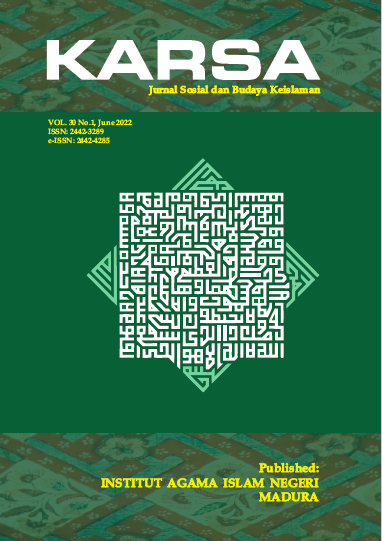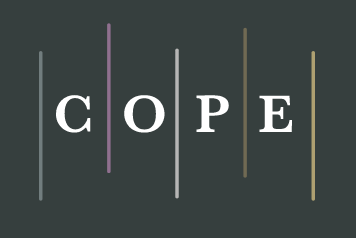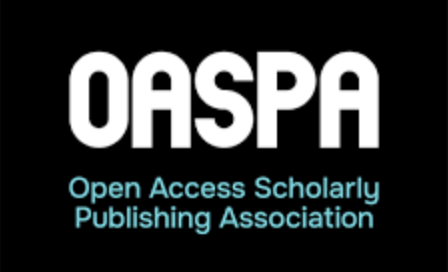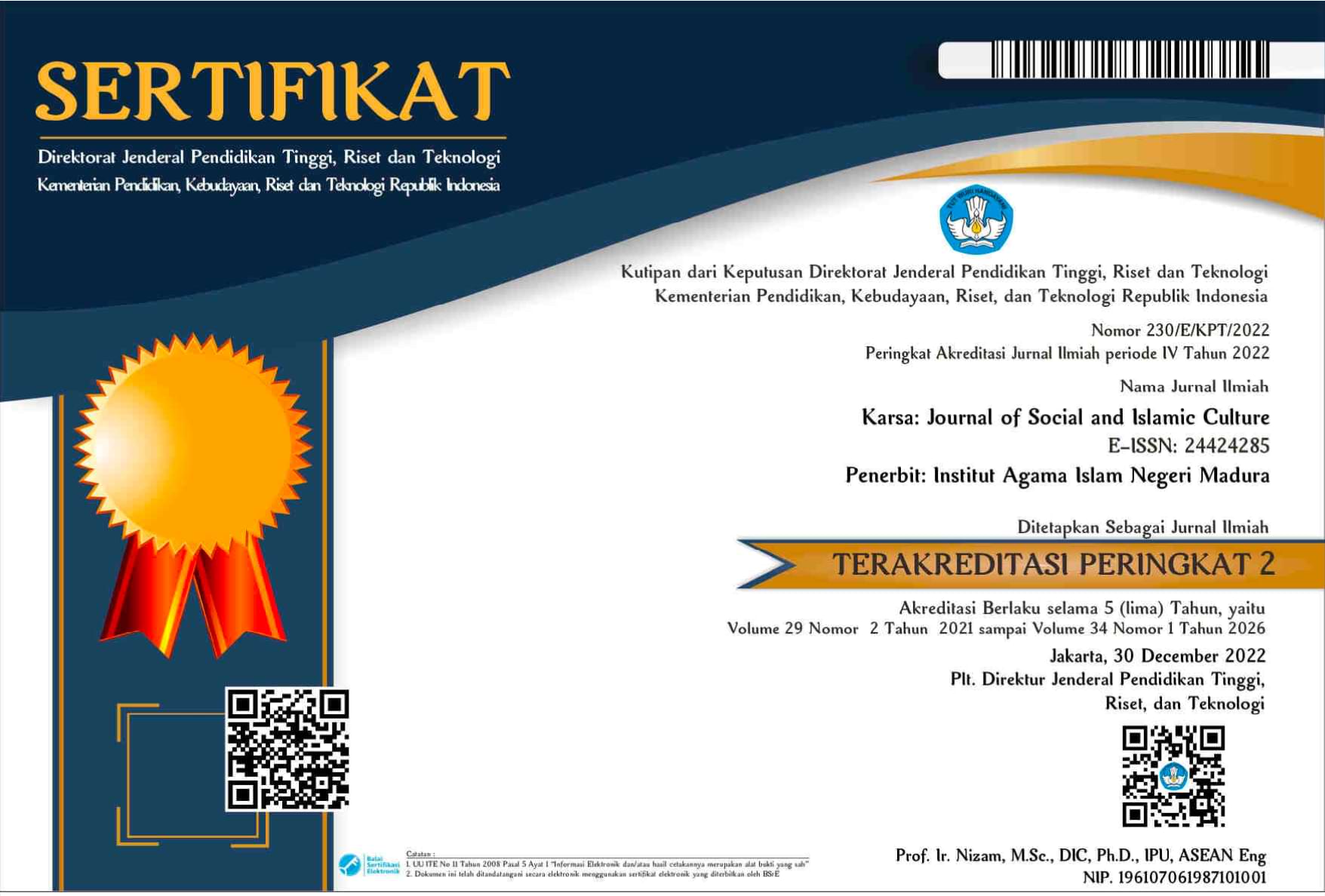The Meaning of Persons with Disabilities in Communities in Da’wah Rules in the City of Parepare
 Abstract views: 729
,
Abstract views: 729
,
 PDF downloads: 379
PDF downloads: 379
Abstract
Sometimes, People with disabilities are underestimated by some people. Even though the government has made a law that contains the rights of persons with disabilities, as contained in Law Number 8 of 2016 about Persons with Disabilities. Islam is a religion of rahmatan lil’alamin, which has its meaning for persons with disabilities. It is implied from the sources of Islamic teachings in the form of the Qur’an and Hadith. Therefore, the existence of government regulations and religious teachings contained in the two sources of Islamic teachings regarding persons with disabilities can influence the attitude of the people in Parepare City to interact with disabilities. This research is field research with a qualitative approach. Data were obtained from interviews, observations, and documentation. Research informan consisted of students, the general public, persons with disabilities, employees of the Social Service Office of Parepare City, and employees of the Ministry of Religion of Parepare City. The study found that most people of Parepare city defined persons with disabilities as not physically limited. In addition, the community can practice ‘da’wah’ towards people with disabilities with quotes (lectures) and their responses and attitudes towards people with disabilities. As a result, the community can behave and walk according to Islamic religious guidance toward persons with disabilities. In addition, the community can also develop related policies for persons with disabilities.
Downloads
References
A, Geminastiti Purinami., Nurliana Cipta Apsari, and Nandang Mulyana. “Penyandang Disabilitas Dalam Dunia Kerja.” Focus: Jurnal Pekerjaan Sosial 1, no. 3 (2018): 234–244. https://doi.org/ 10.24198/focus.v1i3.20499.
Arfa, Faisal Ananda., and Watni Marpaung. Metodologi Penelitian Hukum Islam. Jakarta: Prenada Media, 2018.
BPK Republik Indonesia, “UU No. 4 Tahun 1997 tentang Penyandang Cacat.” Last modified December 1, 2021. https://peraturan.bpk. go.id/Home/Details/37269.
Elisabet Sinaga, Merryanne., and Yurulina Gulo. “Konseling Lintas Budaya dan Agama (Nilai-Nilai pada Masyarakat Suku Batak dalam Melakukan Pendampingan terhadap Disabilitas).” Anthropos: Jurnal Antropologi Sosial dan Budaya 5, no.2 (2020): 96-107.https://jurnal.unimed.ac.id/2012/index.php/antrophos/ article/view/14217/12608.
Ermansyah. Diklat Antropologi, 2015.
Handayana, Sri. “Difabel Dalam Alquran.” INKLUSI: Journal of Disability Studies 3, no. 2 (Desember 2016): 267–284. https://doi. org/10.14421/ijds.030206.
Iskandar, Iskandar., Darussalam Syamsuddin, Natsir Mahmud, and Usman Jasad.“Dakwah Inklusif di Kota Parepare.” KOMUNIDA: Media Komunikasi dan Dakwah 8, no. 2 (2018): 168–182. https://ejurnal.iainpare.ac.id/index.php/komunida/article/view/632.
JDIH BUMN Republik Indonesia, “Undang-Undang Nomor 11 Tahun 2009 Tentang Kesejahteraan Sosial.” Last modified January 2, 2022. https://jdih.bumn.go.id/lihat/UU%20Nomor%2011%20Ta hun%202009.
JDIH BPK Republik Indonesia. “UU No. 8 Tahun 2016 tentang Penyandang Disabilitas.” Last modified Oktober 3, 2021. https:// peraturan.bpk.go.id/Home/Details/37251/uu-no-8-tahun-2016.
Kemenag RI. “Al-’Ankabut - العنكبوت | Qur’an Kemenag.” Last modified November 22, 2021. https://quran.kemenag.go.id/sura/ 29.
Kemenag RI. “Al-Hujurat - الحجرٰت | Qur’an Kemenag.” Last modified November 22, 2021. https://quran.kemenag.go.id/sura/49.
Kemenag RI. “Ali ’Imran - ال ان | Al-Qur’an Kemenag.” Last modified November 22, 2021. https://quran.kemenag.go.id/sura/3/191.
Kemenag RI. “An-Nur - النّور | Qur’an Kemenag.” Last modified November 22, 2021. https://quran.kemenag.go.id/sura/24/61.
Kemenag RI. “Ar-Rum - الرّوم | Al-Qur’an Kemenag.” Last modified November 22, 2021. https://quran.kemenag.go.id/sura/30.
KOMNAS HAM, “Laporan Tahunan Komnas HAM Tahun 2011.” Last modified December 15, 2021. https://www.komnasham.go. id/index.php/laporan/23/laporan-tahunan-komnas-ham-tahun-2011.html.
Kurnia, Fina Tri. “Koping Religius-Spiritual pada Ibu sebagai Caregiver Utama Down Syndrome.” INKLUSI: Journal of Disability Studies 5, no. 1 (30 Juni 2018): 115–132. https://doi. org/14421/ijds.050106.
Lionetti, Timothy M., Edward P. Snyder, and Ray W. Christner. A Practical Guide to Building Professional Competencies in School Psychology. Boston, MA: Springer US, 2011.
Lustiyati, E. Deta., and Merita E. Rahmuniyati. “Aksesibilitas Sarana Sanitasi Bagi Difabel di Tempat Umum.” INKLUSI: Journal of Disability Studies 6, no. 1 (2019): 93–126. https://doi.org/10.14 421/ijds.060105.
Maftuhin, Arif. “Mengikat Makna Diskriminasi: Penyandang Cacat, Difabel, dan Penyandang Disabilitas.” INKLUSI: Journal of Disability Studies 3, no. 2 (2016): 139–162. https://doi.org/10. 14421/ijds.030201.
Mustarjuddin. “Efektivitas Juru Bahasa Isyarat Khutbah di Masjid UIN Sunan Kalijaga.” INKLUSI: Journal of Disability Studies 4, no. 2 (December 2017): 271-296. https://ejournal.uin-suka.ac.id/pusat/ inklusi/article/view/040206/.
Niraviva, Lelly., Priyatno Harsasto, and Laila Kholid Alfirdaus. “Aksesibilitas Penyandang Disabilitas Terhadap Pelayanan Publik di Kota Surakarta.” Journal of Politic and Goverment Studies 7, no. 1 (December 2017): 1–10. https://ejournal3.undip. ac.id/index.php/jpgs/article/view/19073.
PUPR Republik Indonesia. Undang-Undang Republik Indonesia Nomor 8 Tahun 2016 Tentang Penyandang Disabilitas. Last modified December 1, 2021. https://pug-pupr.pu.go.id/_uploads/ PP/UU.%20No.%208%20Th.%202016.pdf.
Rukin. Metodologi Penelitian Kualitatif. Yayasan Ahmar Cendekia Indonesia, 2010.
Santoso, Meilanny B., and Nurliana C. Apsari. “Pandangan Paradigma Pergeseran dalam Disabilitas.” Intermestic: Journal of Internati-onal Studies 1, no. 2 (Mei 2017): 166–76. https://doi.org/10.24 198/intermestic.v1n2.6.
Saputra, Adi Hidayah. “Dinas Kependudukan dan Pencatatan Sipil Pemerintah Kota Parepare.” Last modified December 1, 2021.
https://disdukcapil.pareparekota.go.id/pegawai-negeri-sipil/adi-hidayat-saputra.
Sugiyono.Metode Penelitian Kuantitatif, Kualitatif, dan R&D. Bandung: Alfabeta, 2017.
Widyantini, Ambar Retnosih. “Paradigma Human Right Based dalam Kerangka Hukum Penyandang Disabilitas.” Jurnal Kesejahtera-an Sosial 2, no. 2 (September 2015): 172-179. https://trilogi.ac.id/ journal/ks/index.php/jks/article/view/156.
The journal operates an Open Access policy under a Creative Commons Non-Commercial Share-Alike license. Authors who publish with this journal agree to the following terms:
- Authors retain copyright and grant the journal right of first publication with the work simultaneously licensed under a Creative Commons Attribution License that allows others to share the work with an acknowledgement of the work's authorship and initial publication in this journal.
- Authors are able to enter into separate, additional contractual arrangements for the non-exclusive distribution of the journal's published version of the work (e.g., post it to an institutional repository or publish it in a book), with an acknowledgement of its initial publication in this journal.
- Authors are permitted and encouraged to post their work online (e.g., in institutional repositories or on their website) prior to and during the submission process, as it can lead to productive exchanges, as well as earlier and greater citation of published work.



















